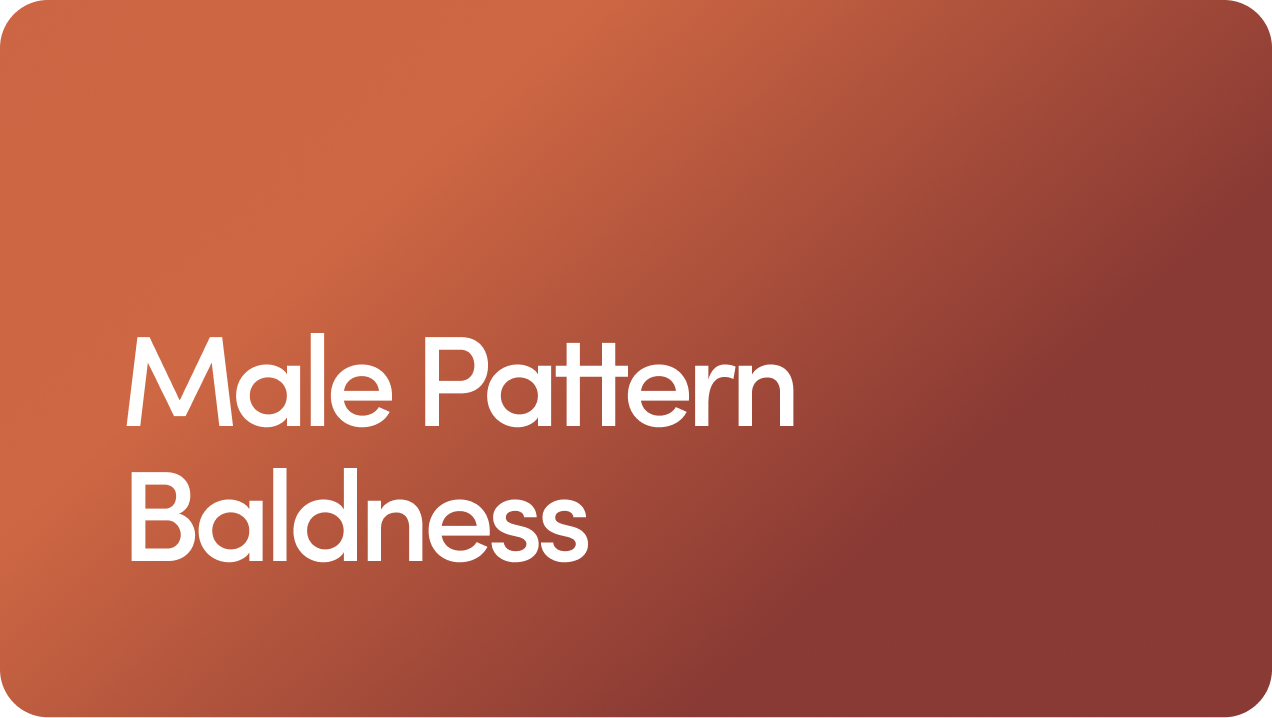Content
FDA approved for more than 25 years
Can Depression Cause Hair Loss?

Depression may be a mood disorder, but it can also show up in physical ways, affecting your appetite, sleep quality, and more. But can depression cause hair loss?
Most hair loss is not caused by depression, but by androgenetic alopecia (male pattern hair loss), which is affected by hormonal and genetic factors.
There may, however, be an indirect link between depression and hair loss. And plus, suddenly losing your hair can impact your self-esteem — which, in turn, can worsen depression.
Fortunately, clinical depression is treatable — and so are most forms of hair loss.
Below, we’ll explore the potential connections between depression and hair loss, as well as treatment options for both conditions.
Content
Can Depression Cause Hair Loss?
There’s a real connection between emotional and physical health. If you’re living with depression, you’re probably quite aware that the condition can take a significant toll on your body.
Research suggests that people with depression are more likely to experience heart disease, diabetes, stroke, chronic pain, or Alzheimer’s disease.
Experts have also identified a link between depression and factors like increased inflammation, changes in heart rate and blood circulation, stress hormone imbalances, and issues with metabolism.
But what about your hairline? Can depression impact your hair? It’s complicated.
While there’s no evidence that depression directly causes hair loss, studies point to a potential link between depression and excess hair shedding.
One 2012 study of adult female dermatology patients showed that of the 54% who reported hair loss, 29% also experienced at least two key symptoms of depression.
Let’s break down three causes of hair loss for which depression can be a potential trigger.
Telogen Effluvium
While stress and depression aren’t one and the same, the emotional distress of living with a mental health condition can worsen daily stress levels — and vice versa.
Stress can play a critical role in certain types of hair loss, particularly telogen effluvium. This is a form of temporary hair loss in which more of your hair follicles than usual enter the resting phase of the hair growth cycle, causing excess hair shedding.
Telogen effluvium can be triggered by acute periods of severe stress (like the kind related to illness or trauma). Similarly, high stress levels can trigger or worsen depression.
As mentioned, telogen effluvium is temporary. A few months after you address the underlying cause of your telogen effluvium, it’s likely you’ll experience hair regrowth.
Trichotillomania
Also known as hair pulling disorder, trichotillomania is a compulsive urge to pull hair from the body.
Trichotillomania is considered a type of obsessive-compulsive disorder. Although it’s not the same as depression, research suggests that people with trichotillomania may be more likely to experience clinical depression than the general population.
OCD is often accompanied by depressive symptoms, too.
Alopecia Areata
Alopecia areata is a condition in which the immune system attacks hair follicles, triggering hair fall. Alopecia areata can often lead to bald patches.
Potential stressors that can cause this type of hair loss include:
Severe stress
Hormonal imbalances
Illnesses like cancer
STIs such as syphilis
These factors can also contribute to depression and chronic stress.
Thyroid Issues, Depression, and Hair Loss
Both depression and hair loss are possible symptoms of hypothyroidism (an underactive thyroid gland).
Your thyroid gland plays a role in many different bodily functions, including brain function and hair growth. When it isn’t performing properly, you might experience a low mood and hair thinning.
Other symptoms of hypothyroidism include:
Fatigue and tiredness
Dry skin
Muscular pain and weakness
Brain fog
Weight gain
High cholesterol
Constipation
Increased sensitivity to cold
If you have several symptoms of hypothyroidism, it’s worth speaking to a medical professional. Thyroid issues are diagnosed via a blood test.
Learn more about thyroid-related hair loss.
Antidepressants and Hair Loss
Hair loss is an uncommon side effect of taking antidepressants, but it can happen.
Newer medications for depression, like some SSRIs and bupropion, come with a higher risk of hair loss, according to a large-scale 2018 study of people taking antidepressants.
Several case studies also suggest a link between sertraline (Zoloft®) and hair loss.
If you think your antidepressants are causing hair loss, don’t stop using your medication before speaking with your healthcare provider. It’s important to speak with them to figure out whether you could use a different antidepressant, and then switch to it in the appropriate way. A professional can also advise you on hair loss treatments — more on this in the next section.
Whether you’re certain your hair loss is related to your depression or not, it’s a good idea to seek professional help if you notice your hair thinning — or any other early sign of balding.
The reason? Most forms of hair loss get worse over time without treatment. It’s important to start treatment ASAP if you have any type of hair loss (unless you’re keen to rock a bald head, in which case, power to you!).
On a more serious note, though, it’s also important to seek help if you think you have clinical depression. While everyone experiences a low mood from time to time, depression is a serious mental health concern that can get better with treatment.
Consider seeking help for depression if:
Your symptoms are getting in the way of your day-to-day life (for example, if it’s affecting your work, relationships, or home responsibilities)
You’re losing interest in your usual passions and hobbies
Your symptoms are bothering you
It feels hard to cope
You’ve had thoughts of self-harm or suicide
Want to take the first step in feeling better? Take a look at our online mental health services and online psychiatry services.
Both depression and hair loss can be frustrating. The good news is that both can be managed with the right support and treatment.
There are plenty of evidence-based hair loss treatment options, including:
Finasteride. An FDA-approved hair loss medication, finasteride reduces your body’s levels of DHT, the hormone that contributes to male pattern baldness. This slows down hair loss. However, it only works for male pattern hair loss.
Minoxidil. Another FDA-approved treatment, minoxidil is a topical hair loss treatment that can be purchased over-the-counter and used for a number of types of hair loss. It’s available as minoxidil foam and minoxidil solution.
Combination treatments. If you have male pattern hair loss, you might benefit from using both finasteride and minoxidil — like in our topical finasteride & minoxidil spray.
Hair loss shampoos. Some shampoos, like our thickening shampoo, contain ingredients that stimulate hair growth.
Hair supplements. If depression is affecting your appetite, you might be struggling to get the nutrients your hair needs to grow well. Try our biotin gummies if you have a vitamin deficiency.
Hair restoration treatments. For more severe hair loss, you might want to consider a hair transplant. While pricey, it’s an effective way to restore hair to bald patches.
If depression is contributing to your hair loss, or vice versa, it’s important to know your treatment options:
Talk therapy. A mental health professional can help you work through the underlying issues contributing to your depression and anxiety. Depression and trichotillomania can be treated with a number of different types of talk therapy, including cognitive behavioral therapy.
Medication. Various medications can help you manage your mental health. There are many different forms of antidepressants out there, so if one doesn’t work for you, another may be more suitable.
Lifestyle changes. Self-care can support your mental well-being, especially when done in conjunction with talk therapy. A regular sleep schedule, frequent exercise, and healthy eating can improve your mood.
A good first step is to speak with a healthcare practitioner — say, your GP or a therapist.
Depression doesn’t directly cause hair loss, but there are some possible explanations as to why you might experience both around the same time.
The connection between depression and hair loss is complicated. But it may be related to stress-related hair loss, trichotillomania (hair pulling disorder), or a side effect of antidepressants.
Hair loss can also impact your mood. Let’s not discount the psychological effect of losing your hair, which may contribute to low self-esteem and bring down your mood.
But both depression and hair loss are treatable. Whether you have one or both, treatment is available. There are many options for treating hair loss and depression.
Noticing the signs of hair loss? Start by consulting a healthcare professional, who can help determine the cause. From there, they can recommend a treatment plan.
Similarly, if you think you’re experiencing depression, don’t hesitate to speak with an expert. A therapist or GP can be a good first port-of-call when you’re feeling low.
If you’re ready to start feeling better, we can help you connect with a healthcare provider from the comfort of your own home.
11 Sources
- Chand SP, et al. (2023). Depression. https://www.ncbi.nlm.nih.gov/books/NBK430847/
- Chronic Illness and Mental Health: Recognizing and Treating Depression. (2024). https://www.nimh.nih.gov/health/publications/chronic-illness-mental-health
- Depression. (n.d.). https://www.nimh.nih.gov/health/publications/depression
- Elyasi, F. (2017). Hair Loss Associated With Sertraline: Two Case Reports and Review. https://www.researchgate.net/publication/317029426_Hair_Loss_Associated_with_Sertraline_Two_Case_Reports_and_Review
- Etminan M, et al. (2017). Risk of Hair Loss With Different Antidepressants. https://journals.lww.com/intclinpsychopharm/Abstract/2018/01000/Risk_of_hair_loss_with_different_antidepressants_.4.aspx
- Grant JE, et al. (2017). Trichotillomania and its clinical relationship to depression and anxiety. https://www.tandfonline.com/doi/abs/10.1080/13651501.2017.1314509
- Hair Loss: Who Gets and Causes. (n.d.). https://www.aad.org/public/diseases/hair-loss/causes/18-causes
- Kıvrak Y, et al. (2015). Diffuse hair loss induced by sertraline use.https://www.ncbi.nlm.nih.gov/pmc/articles/PMC4589582/
- Pereyra AD, et al. (2023). Trichotillomania. https://www.ncbi.nlm.nih.gov/books/NBK493186/
- Patil N, et al. (2024). Hypothyroidism. https://www.ncbi.nlm.nih.gov/sites/books/NBK519536/
- Schmitt JV, et al. (2012). Hair Loss Perception and Symptoms of Depression in Female Outpatients Attending a General Dermatology Clinic. https://pubmed.ncbi.nlm.nih.gov/22714757/
Editorial Standards
Hims & Hers has strict sourcing guidelines to ensure our content is accurate and current. We rely on peer-reviewed studies, academic research institutions, and medical associations. We strive to use primary sources and refrain from using tertiary references. See a mistake? Let us know at [email protected]!
This article is for informational purposes only and does not constitute medical advice. The information contained herein is not a substitute for and should never be relied upon for professional medical advice. Always talk to your doctor about the risks and benefits of any treatment. Learn more about our editorial standards here.
Knox Beasley, MD
Education
Bachelor of Science, Life Sciences. United States Military Academy.
Doctor of Medicine. Tulane University School of Medicine
Training
Dermatology Residency. San Antonio Uniformed Services Health Education Consortium
Certifications
Board Certified. American Board of Dermatology
Medical Licenses
Dr. Beasley is licensed in all 50 states
Affiliations & Memberships
Fellow, American Academy of Dermatology
Specialties & Areas of Focus
Hair Loss, Dermatology
Years of Experience
10 years of clinical practice as a Dermatologist
Previous Work Experience
Medical Director - YouHealth Medical Groups, 2025–
Private practice, 2024–
Chief of Dermatology - , 2015–2019
Publications
Wilson, L. M., Beasley, K. J., Sorrells, T. C., & Johnson, V. V. (2017). Congenital neurocristic cutaneous hamartoma with poliosis: A case report. Journal of cutaneous pathology, 44(11), 974–977.
Banta, J., Beasley, K., Kobayashi, T., & Rohena, L. (2016). Encephalocraniocutaneous lipomatosis (Haberland syndrome): A mild case with bilateral cutaneous and ocular involvement. JAAD case reports, 2(2), 150–152.
Patterson, A. T., Beasley, K. J., & Kobayashi, T. T. (2016). Fibroelastolytic papulosis: histopathologic confirmation of disease spectrum variants in a single case. Journal of cutaneous pathology, 43(2), 142–147.
Beasley, K., Panach, K., & Dominguez, A. R. (2016). Disseminated Candida tropicalis presenting with Ecthyma-Gangrenosum-like Lesions. Dermatology online journal, 22(1), 13030/qt7vg4n68j.
Kimes, K., Beasley, K., & Dalton, S. R. (2015). Eruptive milia and comedones during treatment with dovitinib. Dermatology online journal, 21(9), 13030/qt8kw141mb.
Miladi, A., Thomas, B. C., Beasley, K., & Meyerle, J. (2015). Angioimmunoblastic t-cell lymphoma presenting as purpura fulminans. Cutis, 95(2), 113–115.
Beasley K, Dai JM, Brown P, Lenz B, Hivnor CM. (2013). Ablative Fractional Versus Nonablative Fractional Lasers – Where Are We and How Do We Compare Differing Products?. Curr Dermatol Rep, 2, 135–143.
Siami P, Beasley K, Woolen S, Zahn J. (2012). A retrospective study evaluating the efficacy and tolerability of intra-abdominal once-yearly histrelin acetate subcutaneous implant in patients with advanced prostate cancer. UroToday Int J, June 5(3), art 26.
Siami P, Beasley K. (2012). Dutasteride with As-Needed Tamsulosin in Men at Risk of Benign Prostate Hypertrophy Progression. UroToday Int J, Feb 5(1), art 93. https://www.urotoday.com/volume-5-2012/vol-5-issue-1/48691-dutasteride-with-as-needed-tamsulosin-in-men-at-risk-of-benign-prostatic-hypertrophy-progression.html
Why I Practice Medicine
Dr. Beasley began doing telemedicine while serving in the U.S. Army, providing dermatologic care for soldiers stationed around the world. This experience sparked his passion for telemedicine and inspired his commitment to expanding access to healthcare for patients across the United States.
Hobbies & Interests
In his free time, Dr. Beasley enjoys cooking, reading, and trips to the beach with his wife and two kids (with sunscreen of course).
Related Conditions
 Hair Loss
Hair Loss
 Male Pattern Baldness
Male Pattern Baldness
 Dandruff
Dandruff
 Scarring Alopecia
Scarring Alopecia
 Seborrheic Dermatitis
Seborrheic Dermatitis
